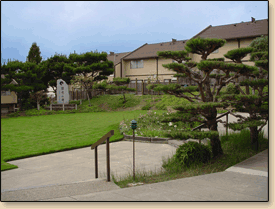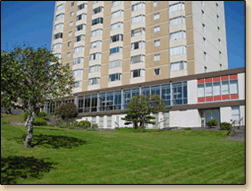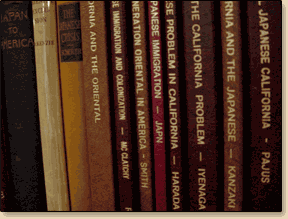 |
|
 |
 |
 |
 |
 |
 |
|
 |
 |
The idea for the Japanese American Library goes back to 1967 when our director Karl Matsushita and Tetsuden Kashima
(now at the University of Washington), discussed the idea of establishing a library in which all Japanese American
materials would be housed under one roof.
The impetus for the Library came in 1969 during the student strike at San Francisco State, when students demanded
the creation of an ethnic studies program. That movement represented one of the first times that different ethnic
groups worked together, setting the precedent for Asian American coalitions. This period marked the beginning of
the cultivation of an Asian American identity, and Karl Matsushita credits the students for providing the foundation.
It was in this atmosphere that the Library was conceived.
Asked by a group of S.F. State students to help develop an ethnic studies curriculum in anticipation of university approval,
Karl Matsushita began compiling basic curriculum materials while Kashima and James Hirabayashi set about establishing some program guidelines.
Since the program's approach was to “tie in the community with the university,” community input was sought.
About 30-40 interested community people and scholars came together to design a curriculum which would incorporate diverse
subjects such as literature, history, sociology and psychology. It was a considerable undertaking since no model for such
a program existed. In essence the curriculum established by this group was implemented at S.F. State University and became
the model for other ethnic studies programs throughout the country, such as those at UCLA and UC Berkeley.
“At that time there was no place in the Japanese American community where anyone could obtain resources about our history, people. I was asked to help put together a curriculum. Many people from the community became involved and offered to help develop materials in their specialties like history and sociology. Since we wanted the library to be located in the community we asked for community support.” (Karl Matsushita)
|
 |
 |
back to top |
 |
 |
 |
 |
|
 |
 |
After the group completed this project, they all thought to themselves, “Since we've got this nice, unique group of people here....it would be a shame to dissolve it.” Consequently the Center for Japanese American Studies was established that year (1969) for educational purposes and was later incorporated. Tetsuden and Karl were given the responsibility of developing a structure for the Center.
They dreamt of a place where programs could be developed to meet the needs of three specific groups in the JA community: the Issei, the youth, and newcomers from Japan, such as the war brides.
“We had a vision back then to have a building built that would house the library, a senior program and a place for the youth. We had big dreams.” (Karl Matsushita)
As it turned out, dreams sometimes can become a reality. Although the other ideas only later came to fruition in the form of Kimochi, the Japanese Community Youth Council, Nobiru Kai and other community organizations, the Center and the beginnings of a JA library were established. The Center continued to exist for many years, sponsoring monthly lectures.
Over the years other people became involved with the Library. From 1969-81, Karl, Tetsuden and another close friend, Richard Kenmotsu, continued to collect Japanese American materials, storing them in their garages. All three were holding down full-time jobs in their respective professions. The turning point in the Library's history came about in 1981. In that year the Center for Japanese American Studies was offered a permanent facility to develop the JA Library--one room in Japantown's Nichibei Kai building. It was an opportunity that couldn't be passed up. And so the Library found a home.
|
 |
 |
back to top |
 |
 |
 |
 |
|
 |
 |
 In 1985 the Library separated from the Center for Japanese American Studies for purposes of finance. The Center was not geared toward raising the kind of money necessary to operate the Library, about $100,000 a year. The first Board of Directors consisted of Steve Doi, Richard Kenmotsu, Karl Matsushita, Yukio Sekino, and Issei Yokota.
In 1985 the Library separated from the Center for Japanese American Studies for purposes of finance. The Center was not geared toward raising the kind of money necessary to operate the Library, about $100,000 a year. The first Board of Directors consisted of Steve Doi, Richard Kenmotsu, Karl Matsushita, Yukio Sekino, and Issei Yokota.
As the collection grew, space, or lack of it, became a major problem for the Library. That precipitated a move in 1987 to its present location at 1619 Sutter St. in the Hinode Towers.
|
 |
 |
back to top |
 |
 |
 |
 |
|
 |
 |
For those familiar with the Library and its services, one cannot mention the Library without mentioning Karl Matsushita's name in
the same breath. He is the director and one of the driving forces of the organization.
A Bay Area resident of many years, Karl was born and raised in Japan. Leaving Japan to attend college at UC Berkeley and the University of Illinois, he majored in sociology earning an advanced degree. He eventually opened a book trading business in San Francisco. Among other things he sold American books to Japan-based clients and helped libraries develop special collections.
With his social science background and book collecting experience libraries would hire him to develop and collect materials
for specific collections. This involved not only compiling a list of basic essential books and materials but also obtaining
these materials from antiquarian dealers (for out-of-print publications) and publishers.
Karl became involved with the Library full-time in 1981. Although Tetsuden and Richard Kenmotsu had moved out of the Bay Area,
the three friends planned to reunite in San Francisco. They had envisioned hiring someone to run the Library because they could
make more money on the outside.
“Back then I was making more money and I didn't want to change my lifestyle. None of us wanted to. But we were dedicated enough that we were going to set aside one-third of our income (to finance the Library's operation). It sounded good at the time.” (Karl Matsushita)
Due to unforeseen circumstances, however Tetsuden and Richard were not able to move to the Bay Area as anticipated leaving Karl
on his own. “We couldn't throw in the towel because we had come this far,” he said. “I guess it's more pride than anything else.” Walking away from the Library was simply too difficult after the years of investment of time, energy and money.
|
 |
 |
back to top |
 |
 |
 |
 |
|
 |
 |
 In the beginning many people involved with the Library sacrificed some of their own savings to help the Library buy books and other materials. Books were acquired at a slow pace, systematically. Over the years the collection grew to more than 4,000.
In the beginning many people involved with the Library sacrificed some of their own savings to help the Library buy books and other materials. Books were acquired at a slow pace, systematically. Over the years the collection grew to more than 4,000.
“We are interested in obtaining anything that has to do with Japanese Americans. If something has been published in English after 1969, most likely we have it in our collection.” (Karl Matsushita)
There are a many privately published books in the collection. Many authors have donated their books to the Library. The Library is also fortunate to get 23 newspapers, all donated.
The Library's role in helping the Center for Japanese American Studies was to provide information and materials on Japanese Americans. Today the Library has one of the best research collections on the Japanese in America.
The Library offers a variety of services used not only by the media and Nikkei community, but by researchers and scholars throughout the United States and Japan. The Library also has a good working relationship with many community groups and universities.
“The Japanese American Library is not only here to provide informational needs for people in our own community, but to help provide a link between us and the general public. We get calls from the major news networks when they want to verify some facts before they air a story. Other people call us to find out anything from a relative who died to researching a paper.” (Karl Matsushita)
 The Library has also built up an extensive collection of camp publication, personal documents of former internees and other documents relating to the evacuation and detention of Japanese Americans. The Library was designated by the National Japanese American Citizens League board and the JACL Legislative Education Committee as their national repository for redress materials.
The Library has also built up an extensive collection of camp publication, personal documents of former internees and other documents relating to the evacuation and detention of Japanese Americans. The Library was designated by the National Japanese American Citizens League board and the JACL Legislative Education Committee as their national repository for redress materials.
“We will continue to work on upgrading our services to become more efficient. I hope people will not just see that our location is changed but come and use our library.” (Karl Matsushita)
The Japanese American Library is not funded by the city, state or any federal agency or organization. For this reason the Library
depends to a certain degree on volunteer work. It is always on the lookout for volunteers. Despite a lack of funding and being sorely undermanned, the Library staff is dedicated and committed. Karen Seriguchi, a past program coordinator, said she enjoyed her job and believed that the Library serves a significant function in the community. In light of dispersed Bay Area Japanese American population, the Library is important for posterity's sake. “Working for the JA Library,” she said, “gives me a feeling of connectedness with the community.”
|
 |
 |
back to top |
 |
 |
|
 |
|

